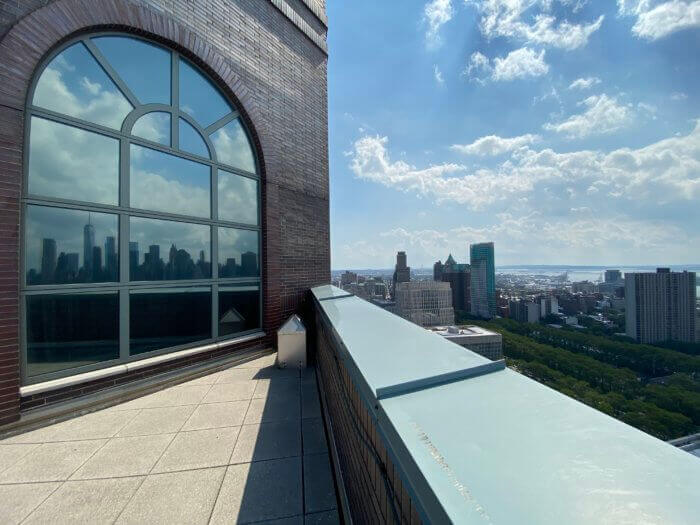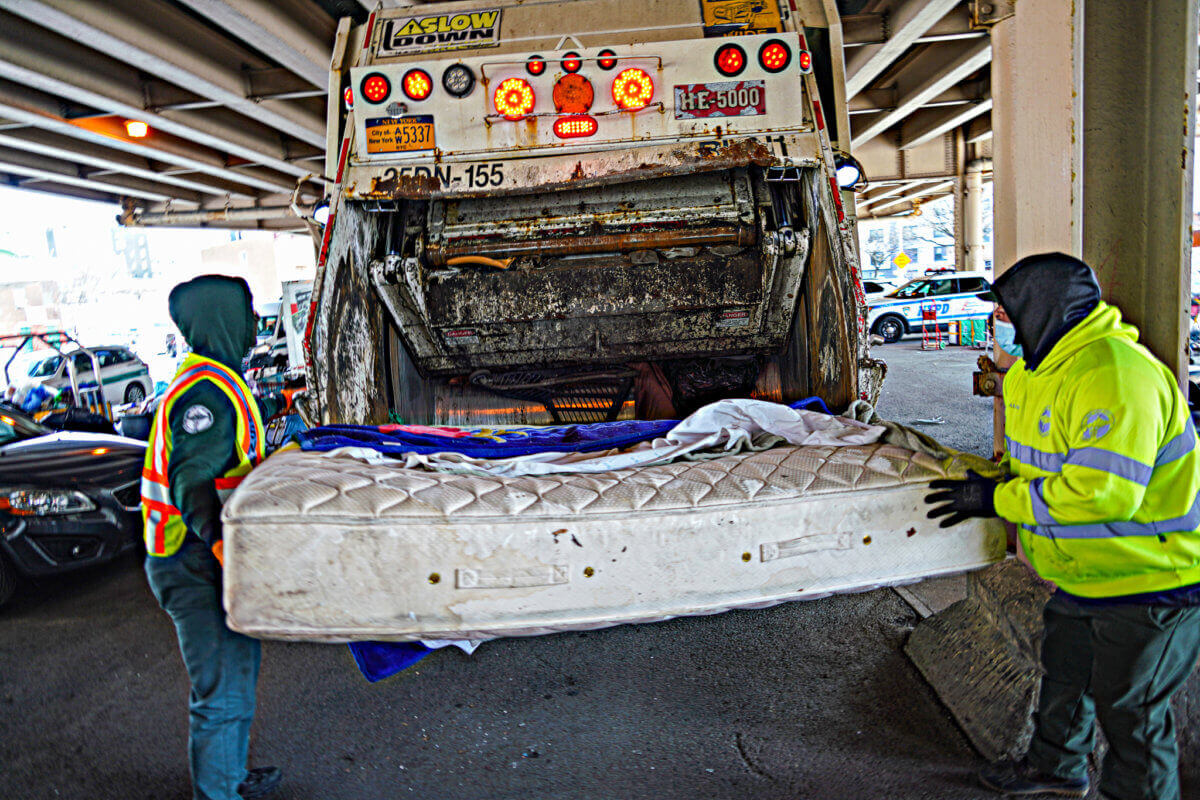Lottery Launches for Affordable Housing at Former Witnesses' Dorm With Supportive Units in DoBro
Starting this summer, a renovated hotel will be home to hundreds of people and families as 90 Sands Street reopens with 490 affordable and supportive housing units.

The building in 2018. Photo by Susan De Vries
Starting this summer, a renovated Dumbo hotel will be home to hundreds of people and families as 90 Sands Street reopens with 490 affordable and supportive housing units — and the lottery for nearly 200 affordable units is open now.
Until June 2, New Yorkers earning between $18,000 and $128,000 per year can apply for one of 185 studio and one-bedroom apartments in the 29-story building, which used to house longterm volunteers with the Jehovah’s Witnesses.
Breaking Ground, a nonprofit that operates thousands of units of supportive and affordable housing and a number of shelters across the city, purchased the building in 2018 with the intent to transform the high-rise into one of their signature developments.
Expected to open to tenants this summer, 90 Sands will house both the 185 affordable apartments and 305 supportive units reserved for formerly homeless people. Unlike a shelter, supportive housing is a permanent, affordable home, with social services meant to help keep each person or family in their home.

“Our first four buildings we opened were all conversion projects,” said Amie Pospisil, Breaking Ground’s Chief Operating Officer. “All in Manhattan, which account for more than 1,200 units, so we’re certainly familiar.”
The city’s Department of Housing Preservation and Development, alongside the New York City Council, financed a significant chunk of the $170 million building purchase, while the renovations were funded through HPD’s Supportive Housing Loan Project and the New York City Housing Development Corporation.
Generally, Pospisil said, 60 percent of units in Breaking Ground’s housing development are supportive units for formerly homeless people, and 40 percent are earmarked “affordable,” meaning they are income restricted. At this building, the affordable units are available to households making anywhere between 30 and 120 percent of Area Median Income. The least expensive studio rents for $537 per month.
“It really feels like a once in a generation opportunity to be able to open a building of this size and in this location,” Pospisil said. “This is not something that comes up often. So being able to bring the volume of units into this space is really quite remarkable.”
According to census data compiled by the city, the median household income in Community Board 2, which includes Downtown Brooklyn, was $100,000 from 2015 to 2019, with 24,000 households making more than 165 percent of the AMI, or more than $137,000 per year for an individual.
But the area’s wealth disparity is large, with 10,000 households considered “extremely low income” by federal standards, and 39 percent of all households paying more than 30 percent of their annual income in rent. According to the Furman Center at New York University, average rent in CB2 was $2,260 in 2019.
At 90 Sands, the least expensive units will rent to single tenants making between $18,412 and $25,080 per year and the most expensive ones to those making between $73,098 – $100,320.
“For folks in the shelter system to move out into that affordable housing provides a real answer both for folks that are in the shelter and are employed, are working, but need that affordable, subsidized housing,” Pospisil said. “It’s also, I think frankly in a lot of ways, prevention. Having affordable housing offers opportunities for folks to have housing and stability in their lives that will prevent them from moving into the shelter system and help to break those cycles of homelessness.”
According to data from the city’s Department of Homeless Services, more than 400 people living in the city’s shelter system had last lived within CB2 in 2020. When someone enters the shelter system, they don’t get to choose which shelter they’ll enter, often being sent to different neighborhoods or boroughs — wherever a bed is available.

That number doesn’t include the number of homeless people living on the street, in subway stations or in vehicles. The city’s most recent survey counted just 117 “unsheltered” homeless individuals living in all of Brooklyn in January 2021, but advocates say those numbers are usually artificially low.
In March, Mayor Eric Adams announced that a special task force would clean up 150 homeless encampments throughout the city by the end of the month. Those cleanups would include outreach workers who would offer people places to stay in city shelters.
By early April, the NYPD had swept more than 300 encampments — but only five people had decided to go to city shelters as of March 30, Gothamist reported. Unsafe conditions, strict rules and instability make the shelter system a dangerous and usually temporary solution.
But 98 percent of people who move into Breaking Ground’s permanent affordable housing units stay long term, Pospisil said.
“It’s the housing that’s best in class and best practice for ending chronic homelessness,” she said. “It really is the solution to helping folks on the street get into housing.”
Onsite services are meant to help people stay put long term, even if their situations change.
“People, sometimes when they move into supportive housing when they first move in looks very different than what they might need five years down the line,” Pospisil said. “So the services really are meant to be scaled and titrated to meet folks wherever they’re at in that cycle of permanent housing.”
That can look like helping to repair relationships with distant family members or getting ready to reenter the workforce.
As the affordable units are filled with the lottery, people will be applying for the units for formerly homeless people through the city, Pospisil said. Some will be referred to the program through street outreach programs in Brooklyn and across the city, and others will be coming from the shelter system.
Despite the success of the supportive housing system, supply is extremely limited.
“For every four or five applicants of affordable housing, there’s only one available unit,” she said. “That doesn’t even account for people who don’t have an application in yet. There’s a lot of different ways we can think about or talk about prioritizing people for the units that are available, but if we had enough units we wouldn’t have to do that.”
Breaking Ground is always on the lookout for eligible buildings, Pospisil said, and the prospect of converting underutilized hotels to supportive is something even Adams has proposed, but the process of getting such an undertaking approved is onerous. It’s something she’d like to see city and state government take initiative on, she said. But for now, opening 90 Sands is a big accomplishment.
“The volume, and being able to to this at this time in this location is really special and important and we’re really excited to be able to do this,” she said.
Editor’s note: A version of this story originally ran in Brooklyn Paper. Click here to see the original story.
Related Stories
- Witnesses’ Dorm Tapped for Low-Income Housing, Not Ian Schrager Hotel
- Locals File Suit to Halt Development at Landmarked Hebron School in Crown Heights
- Brooklynites ID Priorities for the Borough in ‘NYC Speaks’ Survey
Email tips@brownstoner.com with further comments, questions or tips. Follow Brownstoner on Twitter and Instagram, and like us on Facebook.









What's Your Take? Leave a Comment